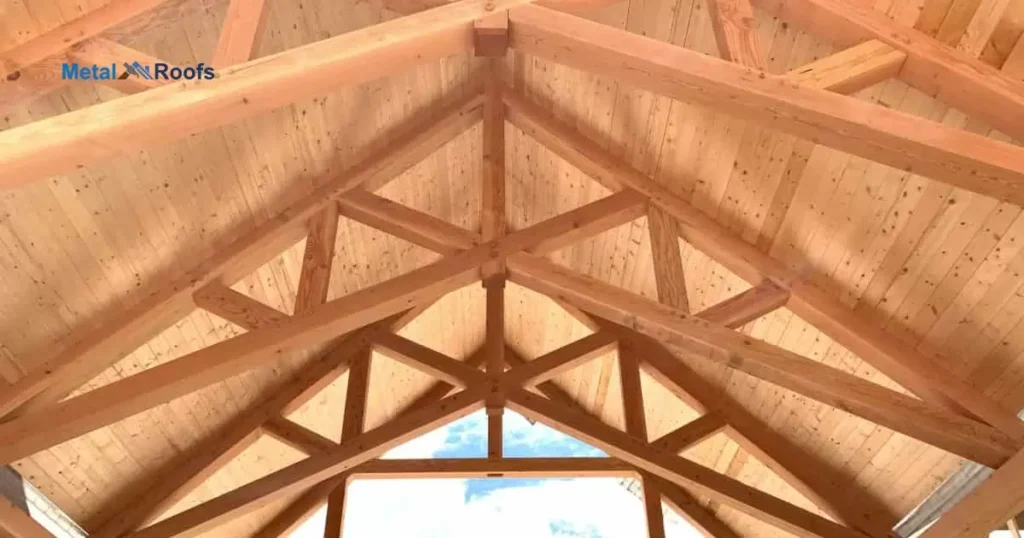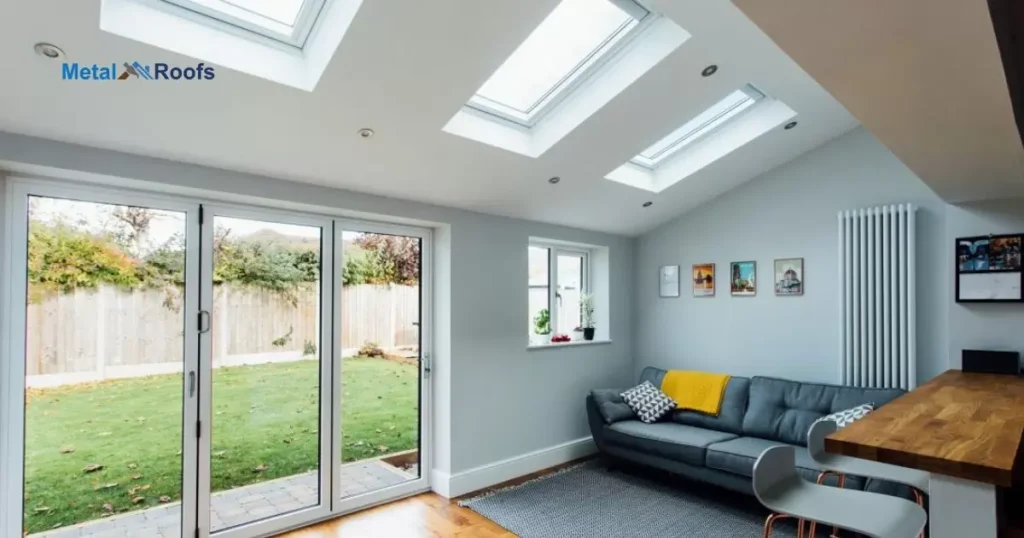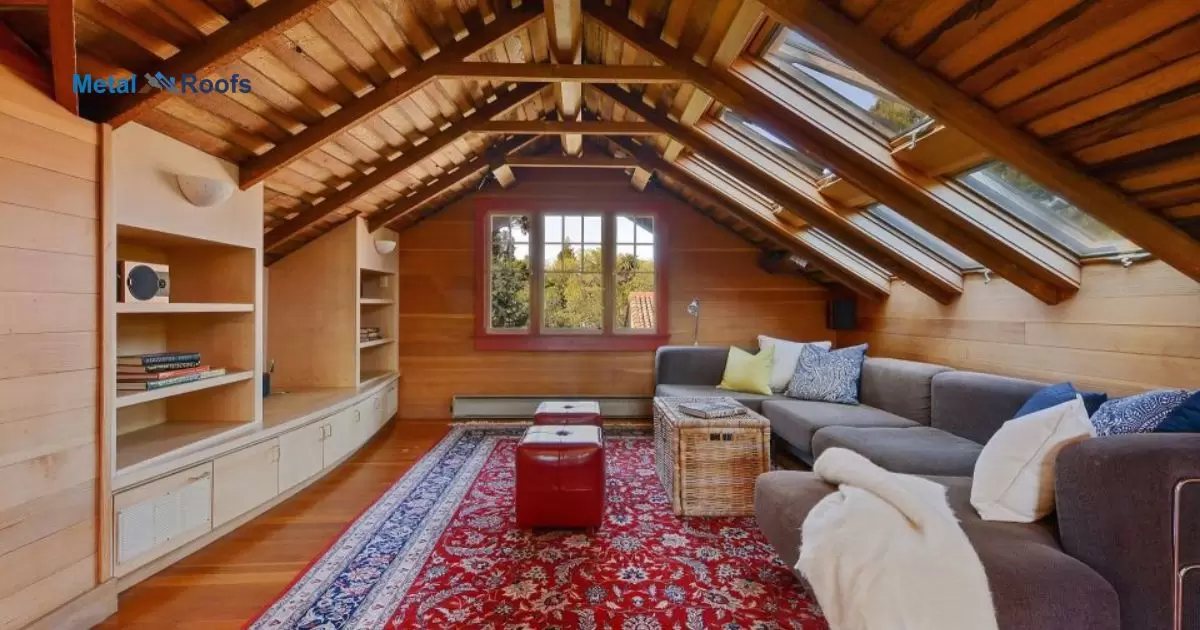Exposed truss skylight has beams on display. Structure is visible from inside. Allows natural light into space. Style blends industrial and modern. Common in lofts and large rooms. Makes a bold architectural statement. Can be customized for any building.
Bring the outdoors inside your space. Natural light pours through beams. exposed truss skylight transforms rooms. Style meets function with flair. Eye-catching statement piece shines. Brighten up your home or office. Elevate any interior with skylights.
Exposed beams add industrial charm, with each secured by screws per metal roof panel. Skylights flood interiors with light. Design blends modern and rustic styles. Open concept spaces feel brighter. Vaulted ceilings get new dimension. Customizable for any building type.
Key Takeaways
- Exposed truss skylights feature visible structural supports.
- They add openness and charm to modern spaces.
- Common in atriums, lobbies, and commercial buildings.
- Flood spaces with natural light, enhancing brightness.
- Require careful engineering for both strength and aesthetics.
Benefits of Exposed Truss Skylights
Exposed truss skylights offer a range of benefits, both practical and aesthetic, making them a popular choice for architectural design and building projects:
Natural Light: One of the primary advantages of exposed truss skylights is their ability to maximize natural light intake.
Visual Appeal: Exposed truss skylights can add a distinctive architectural element to a space, creating a visually striking feature that enhances the overall aesthetic appeal of the building.
Connection to the Outdoors: Skylights provide a connection to the outdoor environment, allowing occupants to enjoy views of the sky, clouds, stars, and natural daylight from within the building.
Ventilation: Some exposed truss skylights are designed to be operable, allowing for natural ventilation.
Energy Efficiency: When properly designed and installed, exposed truss skylights can contribute to the overall energy efficiency of a building.
Design Flexibility: Exposed truss skylights come in various shapes, sizes, and configurations, offering architects and designers flexibility in creating unique and customized spaces.
Health Benefits: Natural light exposure has been linked to numerous health benefits, including improved mood, enhanced cognitive function, and regulation of circadian rhythms.
Value Addition: Incorporating exposed truss skylights into a building’s design can increase its market value and desirability.
Overall, exposed truss skylights offer a combination of functional, aesthetic, and environmental advantages that can enhance the quality and appeal of any architectural space.
Types of Truss Roofs

Truss roofs come in various designs, each suited to different architectural styles, structural requirements, and aesthetic preferences. Here are some common types of truss roofs:
King Post Truss: This is one of the simplest truss designs, consisting of a vertical central post (the king post) with diagonal support members extending from each end to the apex of the roof.
Queen Post Truss: Similar to the king post truss, but with two vertical posts (queen posts) instead of one. This design offers increased stability and can span longer distances.
Howe Truss: Named after its inventor, William Howe, this truss features diagonal members that slope up towards the center of the span, with vertical members (king posts) at the center and at each end.
Fink Truss: This truss is characterized by its W-shaped pattern formed by multiple diagonal members meeting at a central vertical member. It’s a popular choice for its strength and cost-effectiveness.
Fan Truss: In this design, diagonal members radiate out from a central vertical member, resembling the shape of a fan. It’s commonly used in situations where a wide span is required.
Scissor Truss: This truss consists of two intersecting sloped members that cross each other at an angle near the midpoint of the span. It creates a vaulted ceiling space and is often used in cathedral-style roofs.
Bowstring Truss: Typically used in industrial or commercial buildings, this truss features a curved top chord resembling a bow, with diagonal and vertical members supporting the curved shape.
Parallel Chord Truss: Also known as flat trusses, this design features parallel top and bottom chords connected by diagonal and vertical members.
Raised-heel Truss: This type of truss has an elevated section at the end where the bottom chord meets the vertical support, providing more space for insulation and ventilation in the attic.
Gambrel Truss: Resembling the shape of a barn roof, this truss features two different slopes on each side, with a steeper lower slope and a shallower upper slope.
These are just a few examples of the many truss designs available, each offering unique advantages depending on the specific requirements of the building project.
Installing Skylights in Truss Roofs
Installing skylights in truss roofs involves careful planning and precise execution. First, assess the roof’s structure to determine the ideal location for the skylights. Then, reinforce the trusses if necessary to support the additional weight.
Next, cut an opening in the roof that matches the size of the skylight. Install the skylight frame securely, ensuring a watertight seal around the edges. Finally, add flashing and insulation to prevent leaks and maintain energy efficiency.
Choosing the Right Skylight Size

Choosing the right skylight size is crucial for a balanced design. Consider the space where it will be installed. A small skylight may not provide enough light, while a large one might overwhelm the room.
Assess the room’s dimensions and orientation. A skylight that’s too big can lead to excessive heat gain or loss. Conversely, a skylight that’s too small may not capture sufficient natural light. Striking the right balance ensures optimal lighting and energy efficiency, enhancing the overall ambiance of the space.
Designing the Skylight Opening
When designing the skylight opening, consider the size and placement carefully. Ensure it allows ample natural light without compromising structural integrity. The opening should complement the building’s overall design aesthetic.
Start by determining the optimal location for the skylight based on sunlight exposure. Next, decide on the appropriate dimensions for the opening, balancing light intake with potential heat gain. Keep in mind any nearby architectural features that may impact the skylight’s placement.
Preparing the Trusses for Skylight Installation
First, inspect the trusses for any damage or defects. Repair any issues to ensure they can support the skylight securely. Next, reinforce the trusses if necessary to handle the additional weight of the skylight. Once the trusses are inspected and reinforced, measure and mark the precise locations for the skylight installation.
Use accurate measurements to ensure the skylight fits perfectly within the truss framework. After marking the locations, carefully cut an opening in the roof between the trusses. Take care to follow the markings precisely to avoid any mistakes. Then, install any necessary flashing or sealing materials around the opening to prevent leaks.
Installing the Skylights
Installing skylights involves careful planning and precise execution. First, the location for each skylight is determined, considering factors like natural light distribution and structural integrity. Next, the openings are cut into the roof, ensuring they align perfectly with the chosen spots.
Then, the skylights are securely installed into these openings, sealing them tightly to prevent leaks. Once the skylights are in place, attention shifts to finishing touches. Flashing is installed around the edges to provide additional weatherproofing.
Finishing the Skylight Well

Finishing the skylight well is crucial for both aesthetics and functionality. Proper sealing ensures no leaks, protecting the interior from water damage. Quality materials and craftsmanship guarantee longevity and durability.
Choosing the right finishes enhances the overall look of the skylight and complements the surrounding architecture. Attention to detail is key when finishing a skylight. Precision in installation ensures a seamless integration with the roofline. Proper insulation helps regulate temperature and reduce energy costs.
Truss Design Considerations
When considering truss design, it’s crucial to prioritize strength and visual appeal. Structural integrity ensures the truss can support the skylight effectively. Aesthetic considerations involve choosing materials and designs that enhance the overall look of the space.
Careful engineering is essential to achieve both goals simultaneously. Engineers must balance the structural requirements with the desired visual impact. By selecting appropriate materials and configurations, they can create trusses that not only provide support but also contribute to the architectural style of the building.
Lighting and Ventilation
Lighting and ventilation play vital roles in architectural design. Skylights, with their exposed trusses, are excellent sources of natural light, brightening interiors without the need for electricity. This natural illumination creates a welcoming atmosphere, making spaces feel open and airy.
In addition to lighting, skylights also enhance ventilation. They allow fresh air to circulate, reducing the need for artificial cooling systems. This airflow promotes comfort and well-being, contributing to a healthier indoor environment.
Frequently Asked Questions
Can you leave trusses exposed?
Yes, you can leave trusses exposed in architectural design, adding a unique aesthetic while showcasing structural elements.
Can you put a Velux window in a trussed roof?
Yes, you can install a Velux window in a trussed roof. It requires careful planning and specific Velux products for trussed roofs.
Is it worth getting a skylight that opens?
Yes, getting a skylight that opens is worth it. It brings in fresh air, regulates temperature, and enhances the ambiance of your space.
Conclusion
Exposed truss skylights offer both aesthetic appeal and practical benefits. Their visible trusses create a sense of openness and charm in modern spaces. By flooding rooms with natural light and providing ventilation, they enhance comfort and energy efficiency.
Investing in an opening skylight adds further functionality, allowing for fresh air circulation and temperature control. Proper installation is crucial to prevent issues such as leaks or drafts.











